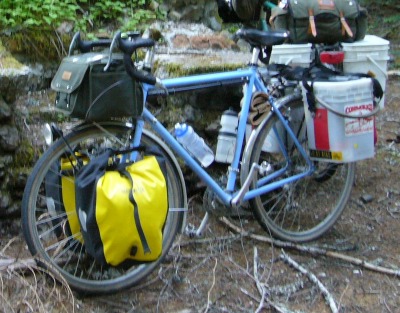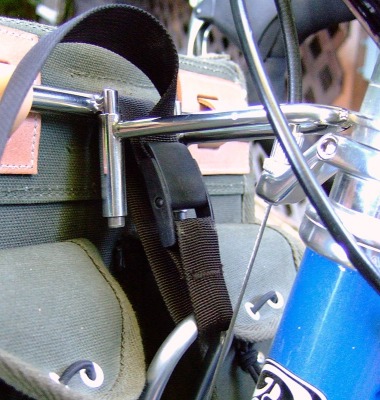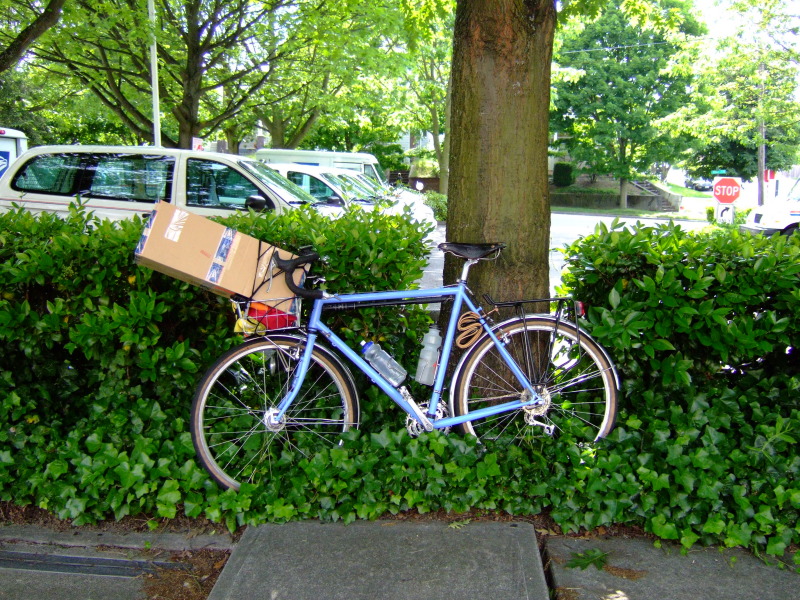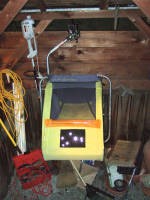Loaded Touring with the Kogswell P/R Prototype
The Kogswell Porteur/Randonneur (aka Kogswell P/R)is getting a lot of buzz in online forums as an exciting new bike. The most interesting this about this bike is not the weird wheel size (584mm aka 650B), or being the first TIG welded Kogswell, or the fact that it fits wide tires. The most interesting thing about this bike is that uses a low trail steering geometry. Just to give customers many options Kogswell is selling the bike with three different forks to allow the customer to tailor the steering geometry and handling of thebike to their needs.
Jan Heine, Mark Vande Kamp and I evaluated the handling differences of the three different forks for Vintage Bicycle Quarterly in Volume 4,Number 3. As a result of that testing I found that I preferred the fork with 40mm of trail. It works well unloaded or with a light rear load and best with a front load.
This was a difficult trip for me to pack for. I was planning on riding the Vancouver Island logging roads with stretches as long as 3 days between towns, so I knew I couldn’t go ultralight. I also was carrying a 5.5lb tent for two instead of the 1.5lb hammock that I’d carry if I was riding solo. While touring I like to use my Cobbworks Oyster Bucket panniers even though they are a little bit heavy because they are waterproof and make great stools in camp or at rest stops.
While planning for this trip I knew that the bike would do best with a front load, but I also wanted to get away with carrying only two panniers and the buckets work best on the rear. As a result my original load looked like this:

Rear Heavy Load (photo by John Speare)
I put most of my food into the front handlebar bag, clothing into one rear bucket, the stoveand a few misc items into the other bucket, and my tent, sleeping bag, and sleeping pad on top. I did not weigh my gear before leavingbut I’d guess that I had about 25# on the rear of the bike and 10# on the front. Lifting the bike made it obvious that there was a heavy rear bias.
It wasclear from the first ride around the ferry terminal parking lot (and sadly 3 hours from home) that this was not the ideal setup. The rear load made the front of the bike too light and the bike would easily shimmy. Larry (a touring partner) pointed out that my buckets were located behind the rear axle,so I slid them as far forward as possible and this helped a great deal,but the handling was still not very good.
That night I thought about how to fix the bicycle’s handling. I knew that I needed to get a front rack, but I didn’t think that putting the buckets on a lowrider rack would leave me with the necessary bag capacity. I still needed somewhere to put my tent, sleeping bag, and pad. I considered using compression straps to fasten those to the rear rack, but decided that I ultimately needed to get some panniers for the front. The Ortlieb Backrollers that I use for commuting were on their way out anyway (after 10 years of daily use), so I decided to purchase a new pair.
The next morning I visited some bike shops in Victoria, BC and purchased a pair of panniers for the front and a lowrider front rack. I moved everything that was strapped down to the rear rack to the front along with a few items from my buckets. It was obvious from my first lifting of the bike that the weight distribution was much better.
This is what the bike looked like with the new gear:

Balanced Load (photo by John Speare)
It was clear that the handling was much better even after a couple of miles. Lesson learned, low trail really does mean having a front or balanced load.
Once properly loaded the Kogswell P/R worked nicely as a loaded tourer. This bike was designed around wide tires and I ran it with the 36mm wide Panaracer CdlV. This tire worked very well on pavement, crushed limestone trails, and dirt logging roads. Even with a heavy front load the bike was comfortable to ride all day, never fought me in the corners, andcould be ridden no hands for short periods.
My bike is a prototype and the list of brazeons differ from the production bikes. The prototype had almost everything that I’d want for touring, but I’d still let to see a few additions. The highest priority would be having a third waterbottle cage location mounted under the downtube. Two bottles of water is good, but three is even better. My prototype didn’t come with mid-fork brazeons for a front lowrider, but I know that they have been added to the production frames. Otherwise the bike has everything necessary for loaded touring.
On my next trip I think I’ll concentrate on having a load biased towards this front. This will probably mean using the same handlebar bag, two buckets mounted on front lowriders, and a large saddlebag in the rear with no rear rack. I think that this would have provided the capacity needed for this trip while optimizing the load balance for this bike. For an overnight trip I would probably use only a handlebar bag and two small front panniers.
When I sold my previousloaded touring bike I was wondering if I made a mistake in assuming that the Kogswell P/R would be up to this sort of use. After 5 days on the road I’m here to report that it is, as long as you are careful to put at least half of your touring load up front. The bike really is a joy to ride when well loaded and I hope to use it on many trips to come.



















